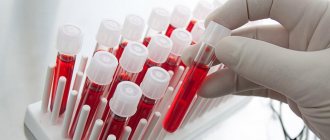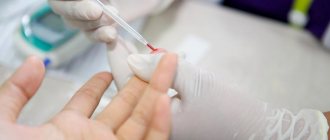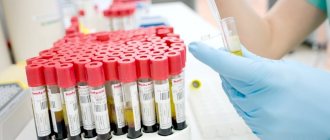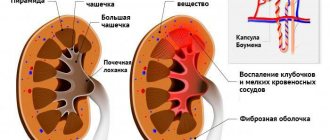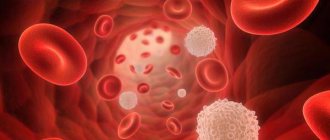Editor
Daria Tyutyunnik
Doctor, forensic expert
To avoid the development of dangerous complications, it is necessary to undergo a full diagnosis in a timely manner and begin treatment on time. The treatment method is selected based on data on the patient’s condition, clinical signs of the disease, as well as diagnostic results.
Let's take a closer look at one of the most important laboratory tests necessary both for making a diagnosis and for assessing the patient's condition - blood tests.
General
If the development of pneumonia in an adult is suspected, a detailed general blood test is always prescribed to the patient. The need for research is explained by the principles of disease development. The main cause of pneumonia is the penetration of pathogenic microorganisms into the body. In a normal state of the immune system, these microorganisms are destroyed. Otherwise, when the immune system cannot cope with the infection, the disease develops.
Pneumonia is based on inflammation of the lung tissue of an infectious nature. In response to the development of infection in the body, processes aimed at combating pathology are activated, which distorts the composition of the blood. The latter contains waste products of bacteria, which is also displayed in the analysis.
Let's consider what the blood will show and how its composition will change during pneumonia.
Red blood cells
These are blood cells whose main task is to transport oxygen from the lungs to every cell of the body, as well as reverse transport of carbon dioxide. The normal values of red blood cells are 3.5-4.7 × 10 to the 12th power per liter for women and 4-5 × 10 to the 12th power per liter for men.
With the development of pneumonia, accompanied by oxygen starvation, the concentration of red blood cells in the blood increases. This indicator grows in proportion to the progression of the pathological process and shows the stage of its development. This is how the body's defense mechanism works in attempts to resist pathogenic bacteria or viruses. Thus, elevated red blood cell readings indicate inflammation of the lung tissue.
Leukocytes
These cells provide specific and nonspecific protection of the human body. Otherwise, leukocytes are called white blood cells of the immune system. Their main task is to combat the suppression of pathogenic bacteria, as well as the removal of their waste products from the body. Normally, in an adult, the content of leukocytes varies from 4 to 9 × 10 to the 9th power per liter.
The inflammatory process in the lungs always accompanied by an increased content of leukocytes; their increased production is explained by the activation of the body’s protective functions.
Lymphocytes
Another type of cell that is part of the defense mechanism. According to research data, a good indicator is when 100% of leukocytes account for about 20-40% of lymphocytes. These blood cells ensure the recognition of foreign life forms and the production of antibodies. An increased content of lymphocytes signals the development of pneumonia, the cause of which was a viral infection of the body.
Hemoglobin
It is a component of the cellular formula of red blood cells, designed to absorb oxygen and transfer it to various tissues of the human body. Normally, a healthy woman’s hemoglobin levels are 120-150 g/l, and a man’s are 130-170 g/l. With pneumonia, the body receives less oxygen, which is reflected in a blood test by reduced hemoglobin levels.
ESR
The erythrocyte sedimentation rate (ESR) tells how quickly red blood cells sediment. In women, the normal speed is considered to be 2-16 mm/h, where the average is 15 mm/h. In a man, normal ESR values range from 2-10 mm/h. Analysis of ESR can be very important, since the results can determine the degree of progression of the inflammatory process.
Online test for pneumonia detection
Reticulocytes
They are synthesized by the bone marrow and can transform into red blood cells. Normal levels of their concentration are 0.67-1.19% in men and 0.59-2.07% in women. In severe disease, the concentration of reticulocytes increases to replenish or increase the number of red blood cells. This is how our body’s defense mechanism works, and a quantitative increase in red blood cells also indicates inflammation.
Neutrophils
One of the types of leukocytes, which takes part in the creation and maintenance of immunity by the body, plays an important role in resisting bacteria. All neutrophils are divided into mature and immature, also called band and segmented, respectively. Normally, in an adult, the indicators of segmented neutrophils vary between 47-72%, and band neutrophils - 1-6% of the total number.
Leukocyte formula
The study allows us to obtain information about the percentage of individual types of leukocytes in relation to their total number.
Any deviations from the norm may indicate the development of an inflammatory process in the body. The results determine a shift in the leukocyte formula to the left or right, which indicates the following changes:
- Shift to the left – an increase in the concentration of immature neutrophils (over 6%), the appearance of myelocytes and metamyelocytes. This result is characteristic of pneumonia and other infectious inflammatory processes.
- Shift to the right – a decrease in the number of mature (below 47%) and an increase in the number of immature neutrophils (above 6%). This result may occur in people living in an area of radioactive contamination.
Expert opinion
Anna Sandalova
Pulmonologist, doctor of the highest category
Ask a Question
In many cases, blood tests vary between children, adults and pregnant women, and vary by gender. There are standards for children, adults and pregnant women, which must be consulted in each individual case.
Antibodies
Early diagnosis of pneumonia becomes possible by performing blood tests such as:
- polymerase chain reaction (PCR),
- enzyme immunoassay (ELISA),
- indirect immunofluorescence reactions (IRIF),
- complement fixation (CPF),
- hemagglutination aggregate (HAHA),
- determination of the titer of specific immunoglobulins.
Thanks to these methods, it is possible to determine the nature of the pathogen. This is especially true for atypical forms of pneumonia. Thus, with chlamydial and mycoplasma pneumonia, antibodies appear in the blood serum - immunoglobulins of classes A, G and M. During the study, it is possible to obtain the following results:
- Immunoglobulins M are produced in the body during primary infection; their increase indicates an acute process.
- The presence of IgG is a sign of a long course of the pathological process.
- The IgG and IgM results are negative – there is no infection in the body.
To correctly evaluate the results, you should use the principle of paired sera - repeat the analysis after 2-3 weeks, compare the results obtained with the previous ones. This will allow you to track the dynamics and draw conclusions about the development of the pathological process.
A blood test for antibodies is a highly informative and accurate diagnostic method that helps clarify the diagnosis of a certain type of pneumonia in a patient.
Additional research methods
For pneumonia, sputum examination is also prescribed. It allows you to determine the cause of the pathology and identify the pathogen. If a general blood test shows leukocytosis, a sputum test for pneumonia will be aimed at looking for bacteria or fungi.
Diagnosis is rarely complete without urine testing. In pneumonia, protein is found in it, as well as a small number of red blood cells.
Radiation diagnostic methods are also used, which include:
- radiography;
- fluorography;
- fluoroscopy;
- linear or computed tomography.
Pneumonia cannot be diagnosed by a blood test in children or adults. Identifying pathology requires an integrated approach. This will not only confirm pneumonia, but also find out its causes. As a result, the doctor is able to select an adequate treatment regimen.
Biochemical
Blood biochemistry is an equally important study when inflammation of the lung tissue occurs. Even though it does not allow you to see and analyze specific indicators. The main purpose of biochemical analysis is to detect metabolic disorders , if any. Biochemistry makes it possible to identify dysfunction of certain organs, assess the degree of progression of the pathological process, and even determine in which organ it developed.
By conducting a biochemical analysis, we can say for sure that a person has pneumonia, especially if there are corresponding symptoms. Using biochemistry, the presence of pathogenic microflora in the body, as well as its waste products, is determined.
Why is biochemistry needed?
In addition to a general blood test, when diagnosing pneumonia in children, a biochemical test is taken. If complications develop in the baby’s body, which occur in the form of respiratory failure, oxygen starvation of the tissues is observed. Biochemical analysis allows you to evaluate all the necessary indicators and prevent the development of complications in the future.
Standards for biochemical analysis
When conducting biochemistry, the following indicators are taken into account:
- Total protein. This element remains within normal limits.
- Globulins: alpha and gamma. Their number is increasing significantly. These elements are responsible for fighting inflammation and, if it is present, their number increases significantly.
- Fibrinogen. These values are slightly overestimated.
- LDH. There is an increase, in particular, in the LDGZ fraction synthesized in lung tissue, but the indicator is not very high.
- C-reactive protein. As a rule, the level is overestimated or significantly overestimated.
As a rule, a blood test for pneumonia in children is a good reason for further diagnosis if the indicators deviate from the norm. Biochemistry is carried out in conjunction with basic research and is an addition to the general one.
What indicators in adults indicate pneumonia?
Previously, indicators by which one can determine the development of the inflammatory process in the lungs have already been touched upon. However, to complete the picture, it is worth identifying obvious clinical indicators indicating the development of pneumonia:
- Segmental leukocytosis - an increase in the content of immature leukocytes over 5% of the norm. It is the increased number of immature cells that indicates activation of the immune system, which indicates the development of pathology and the presence of inflammation.
- Increased ESR - an alarming indicator is ESR levels reaching approximately 25 mm/h; if the disease has reached a severe form, this figure increases to 40-50 mm/h.
- Lymphocytosis - if pneumonia is of viral origin, the percentage of lymphocytes in the blood increases.
In addition to the above, do not forget about the decrease in hemoglobin, the increase in the content of red blood cells and reticulocytes.
Why is a blood test prescribed for pneumonia?
A test for the presence of pneumonia is prescribed under certain circumstances, the diagnostic criteria for which are:
- data from the collected anamnesis;
- the results of the initial examination - elevated temperature, which does not always indicate the severity of the disease, signs of intoxication, cough, respiratory failure;
- listening with a phonendoscope – crepitation, presence of wheezing;
- tapping of the pulmonary fields - the percussion sound is dull;
- decrease in acidity (metabolic or mixed).
The diagnosis can be confirmed based on the results of a lung x-ray, which show focal infiltrates. Tests for pneumonia are required to determine the severity of the inflammation, as well as the effectiveness of the prescribed treatment. However, they do not play a leading role in making a diagnosis.
How to prepare for the procedure?
Serious preparation for taking blood tests is not required, but it is important to follow some rules so as not to distort the results of the study:
- The test is taken on an empty stomach - the last meal is taken at least 8 hours before the biomaterial is taken.
- The collection of biomaterial is carried out in the morning, and in the morning you are allowed to drink only water. Sweet tea and especially coffee can distort the results.
- Drinking even small doses of alcohol is prohibited at least 24 hours before donating blood.
- Do not smoke for at least an hour before the procedure.
- The medications taken by the patient can greatly distort the results. Therefore, before collecting biomaterial, you must inform your doctor about the medications you are using.
Important! To conduct a general analysis, biomaterial is collected from a finger. If a biochemical study is required, venous blood sampling is necessary. Moreover, the preparation rules are the same for both types of research.
For what symptoms is a study prescribed?
The first two days, the causative agent of pneumonia causes symptoms similar to those of a cold or flu. Each of the symptoms must be taken into account. It is important to seek medical help promptly. The primary symptoms of pneumonia are:
- high (up to 40 degrees) temperature that does not subside for two to three days;
- swelling of the nose, blueness of its wings;
- pale skin;
- pain in the chest, throat and trachea;
- chills;
- varied cough - dry or wet, in fits and starts, with sputum, pus, wheezing;
- shortness of breath, rapid heartbeat;
- general lethargy, desire to sleep.
Reference materials (download)
Click on the required document to download:
| # | File | file size |
| 1 | Laboratory and instrumental standards | 145 KB |
| 2 | Laboratory standards (blood, biochemical, feces, respiratory function, etc.) | 218 KB |
| 3 | Diagnosis of respiratory diseases. Hams | 9 MB |
| 4 | Diagnosis and treatment of community-acquired pneumonia. Infectious Diseases Society of America Guidelines | 833 KB |
| 5 | Diagnostic algorithms and protocols for providing medical care for pneumonia | 3 MB |
| 6 | Lung studies and major syndromes | 199 KB |
Take a free online test for pneumonia
Time limit:
out of 17 tasks completed
Questions:
- 1
- 2
- 3
- 4
- 5
- 6
- 7
- 8
- 9
- 10
- 11
- 12
- 13
- 14
- 15
- 16
- 17
Information
Will this test help you determine if you have pneumonia?
You have already taken the test before. You can't start it again.
The test is loading...
You must log in or register in order to begin the test.
You must complete the following tests to start this one:
results
Time is over
- Your health is fine now. Don’t forget to take good care of your body, and you won’t be afraid of any diseases.
- The symptoms that are bothering you are quite extensive, and are observed in a large number of diseases, but we can say with confidence that something is wrong with your health. We recommend that you consult a specialist and undergo a medical examination to avoid complications. We also recommend that you read the article on how to recognize pneumonia at home.
- In your case, there are clear symptoms of pneumonia! However, there is a possibility that it could be another disease. You need to urgently contact a qualified specialist; only a doctor can make an accurate diagnosis and prescribe treatment. We also recommend that you read the article about whether pneumonia can be cured without antibiotics and how to do it.
- 1
- 2
- 3
- 4
- 5
- 6
- 7
- 8
- 9
- 10
- 11
- 12
- 13
- 14
- 15
- 16
- 17
- With answer
- With a viewing mark
- Task 1 of 17
- Yes, daily
- Sometimes
- Seasonal (eg vegetable garden)
- No
- Task 2 of 17
- Yes
- No
- Only when sick
- I find it difficult to answer
- Task 3 of 17
- Yes, I live permanently
- No
- Yes, I work in such conditions
- Previously lived or worked
- Task 4 of 17
- Constantly
- I'm not there
- Previously was
- Rarely, but it happens
- Task 5 of 17
- Yes, pronounced
- No more than usual
- No, that didn't happen
- Task 6 of 17
- Yes
- No
- Task 7 of 17
- Yes
- Used to smoke
- Sometimes
- No, and never smoked
- Task 8 of 17
- Yes
- Used to smoke
- It happens sometimes
- No and have never smoked
- Task 9 of 17
- Yes
- No
- Task 10 of 17
- Yes
- No
- Task 11 of 17
- Yes, innate
- No, my heart is fine
- Task 12 of 17
- Yes, and the cough is severe
- Worried, but the cough is wet
- No
- Task 13 of 17
- Yes, I feel terrible
- Mild fatigue, not critical
- No, I feel great
- Task 14 of 17
- Yes
- No
- Task 15 of 17
- Yes, and very much so
- There is a slight feeling of discomfort
- No
- Task 16 of 17
- Yes, very strong
- No more than usual
- No
- Task 17 of 17
Leukocyte formula and its shift
As you know, leukocytes are just a general name for blood elements that fight inflammation. Among them there is a whole variety of cell types, each of which performs its own specific function.
Thus, depending on the color of the leukocyte under a microscope, colorless neutrophils, purple basophils and pink eosinophils are distinguished. In pneumonia, there is an increase in neutrophil cells (neutrophilia).
Neutrophils differ in age. Young (band cells) normally account for up to 5% of all leukocytes, while mature (segmented) cells predominate, accounting for about 60%. This ratio is typical for a healthy body. With pneumonia, it is sharply disrupted.
In order for the immune system to resist infection, an increase in the number of young cells is required, and the number of rod elements begins to increase sharply. These changes are called a shift of the leukocyte formula to the left, since young cells in the table are located to the left of mature ones.
